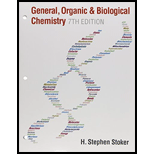
Concept explainers
Interpretation: To determine the number of moles of ATP available for cellular use if 3 moles of NADH and 4 moles of FADH2 are oxidized within a mitochondrion.
Concept introduction: Electron transport chain
FADH2 is the reduced form of flavin adenine dinucleotide. The main function of flavin adenine dinucleotide is to act as an oxidizing agent and used by the cell in oxidation reactions like oxidation of fatty acid.
NADH is the reduced form of nicotinamide adenine dinucleotide. It is employed as an oxidizing agent in various reactions like oxidation of secondary alcohol into a
Trending nowThis is a popular solution!

Chapter 23 Solutions
Bundle: General, Organic, and Biological Chemistry, 7th + OWLv2 Quick Prep for General Chemistry, 4 terms (24 months) Printed Access Card
- In the presence of excess oxygen, a complete oxidation of seven molecules of glucose into carbon dioxide and water, by a yeast cell, would produce approximately ATP molecules via oxidative phosphorylation only. (Consider NADH = 3 ATP and FADH2 = 2 ATP)arrow_forward1 a) What is meant by the ATP currency exchange ratio? Why does the oxidation of mitochondrial FADH2 generate one less ATP than oxidation of mitochondrial NADH? b) If 12 H+ are moved across the inner mitochondrial membrane by NADH oxidation, and each ATP synthesized requires 3 H+ to move through ATP synthase, why are only 3 ATP molecules produced by oxidation of each NADH?arrow_forwardHow many ATP are produced when 3 moles of FADH2 enter the electron transport chain?arrow_forward
- What would be the effect on ATP and NADH production (how many ATP and NADH could be produced from one molecule of glucose) if pyruvate transport into the mitochondrion were inhibited?arrow_forwardAssuming all the NADH+H+ and FADH2 are used for oxidative phosphorylation, how many net ATP are made from 1 molecule of glucose? (hint: don’t forget to also include substrate level phosphorylation)arrow_forwardWhat is the total number of H+ transferred from matrix to intermembrane space of the mitochondria by complexes I, II and III for every 2 electrons movement? What would be the total amount of ATP synthesized (explain)?arrow_forward
- If 30 molecules of acetyl CoA enter into the mitochondria in the presence of O2, how many molecules of ATP will be formed through oxidative phosphorylation?arrow_forwardHow does DCPIP act as an indicator of presence of mitochondria? Will mitochondria in the presence of DCPIP still make ATP? Why or why not?arrow_forwardWhat metabolites accumulate when azide is added to actively respiring mitochondria?arrow_forward
- What will happen to the proton (H+ions) gradient in the mitochondria if the inner membrane is punctured?arrow_forwardUnder standard conditions, NADH reoxidation by the electron-transport chain has a free-energy change equal to –220 kJ/mol. With 100% efficiency, how many ATP could be synthesized under standard conditions? What is the "actual" efficiency given these numbers?arrow_forwardFreshly prepared mitochondria were incubated with β-hydroxybutyrate, oxidized cytochrome c, ADP, Pi, and cyanide. β-hydroxybutyrate is oxidized by an NAD+-dependent dehydrogenase. The experimenter measured the rate of oxidation of β-hydroxybutyrate andthe rate of formation of ATP.(a) Indicate the probable flow of electrons in this system.(b) How many moles of ATP would you expect to be formed per mole ofβ-hydroxybutyrate oxidized in this system?(c) Why is b-hydroxybutyrate added rather than NADH?(d) What is the function of the cyanide?(e) Write a balanced equation for the overall reaction occurring in thissystem (electron transport and ATP synthesis). (f) Calculate the net standard free energy change (ΔG°') in this system,using E'0 values from Table 14.1 and a ΔG°' value for ATP hydrolysisof -32.2 kJ/mol.arrow_forward
 Human Anatomy & Physiology (11th Edition)BiologyISBN:9780134580999Author:Elaine N. Marieb, Katja N. HoehnPublisher:PEARSON
Human Anatomy & Physiology (11th Edition)BiologyISBN:9780134580999Author:Elaine N. Marieb, Katja N. HoehnPublisher:PEARSON Biology 2eBiologyISBN:9781947172517Author:Matthew Douglas, Jung Choi, Mary Ann ClarkPublisher:OpenStax
Biology 2eBiologyISBN:9781947172517Author:Matthew Douglas, Jung Choi, Mary Ann ClarkPublisher:OpenStax Anatomy & PhysiologyBiologyISBN:9781259398629Author:McKinley, Michael P., O'loughlin, Valerie Dean, Bidle, Theresa StouterPublisher:Mcgraw Hill Education,
Anatomy & PhysiologyBiologyISBN:9781259398629Author:McKinley, Michael P., O'loughlin, Valerie Dean, Bidle, Theresa StouterPublisher:Mcgraw Hill Education, Molecular Biology of the Cell (Sixth Edition)BiologyISBN:9780815344322Author:Bruce Alberts, Alexander D. Johnson, Julian Lewis, David Morgan, Martin Raff, Keith Roberts, Peter WalterPublisher:W. W. Norton & Company
Molecular Biology of the Cell (Sixth Edition)BiologyISBN:9780815344322Author:Bruce Alberts, Alexander D. Johnson, Julian Lewis, David Morgan, Martin Raff, Keith Roberts, Peter WalterPublisher:W. W. Norton & Company Laboratory Manual For Human Anatomy & PhysiologyBiologyISBN:9781260159363Author:Martin, Terry R., Prentice-craver, CynthiaPublisher:McGraw-Hill Publishing Co.
Laboratory Manual For Human Anatomy & PhysiologyBiologyISBN:9781260159363Author:Martin, Terry R., Prentice-craver, CynthiaPublisher:McGraw-Hill Publishing Co. Inquiry Into Life (16th Edition)BiologyISBN:9781260231700Author:Sylvia S. Mader, Michael WindelspechtPublisher:McGraw Hill Education
Inquiry Into Life (16th Edition)BiologyISBN:9781260231700Author:Sylvia S. Mader, Michael WindelspechtPublisher:McGraw Hill Education





